The 2016 Ford F250s were powerhouses when it came to their overall towing capacity, having ratings as high as 16,600 lbs.! On the flip side of that, it is possible that you would have a substantially lower overall rating that was more than 4,000 pounds less, if your truck lacked certain requirements, which I go into in this article.
Let's dive into some of the numbers and take a look at the data, so you can find out exactly how capable your truck actually is.
I recommend that you read through your owner's manual yourself to get familiar with your truck and that you adhere to all of Ford's requirements and recommendations.
2016 F-250 Overview
Overall Towing Capacity: The overall towing capacity for the 2016 F250s ranged from 12,200-16,600 lbs. And was dependent upon the engine you had equipped, your axle ratio oh, your cab configuration and whether you had a two-wheel drive or four-wheel drive truck.
If you were using a conventional hitch, then you were only able to achieve 14,000 lbs., compared to the gooseneck or fifth wheel hitch that was able to achieve that higher 16,600 lb. rating
Engine Options: There we're two different engine optionsavailable and these were the 6.2 L engine and a 6.7 L engine. The 6.2 L engine was a gas engine, while the 6.7 L was a diesel powered engine. There were different axle ratios available for each engine, so it would be hard to compare the data but if we look at the cab configurations, we can see that for super cab and crew cab models, trucks that had the diesel engine equipment had a significantly higher maximum trailer weight rating, compared to models that had the gasoline powered engine.
Axle Ratios: Like I mentioned earlier, each engine configuration had different axle ratios associated with that engine, so it would be hard to compare the trailer weight ratings based on that fact. The axle ratio options for these trucks were available as the: 3.31, 3.55, 3.73 and the 4.30 axle ratios.
If you had the 6.2 L engine equipped, then you only have the choice between the 3.73 and 4.30 axle ratios. On the other hand, if you had the 6.7 L diesel engine equipped, then you're to axle ratio choices we're between the 3.31 and 3.55 ratios.
Assumed Weight: I was able to find an additional note where Ford specifies that the maximum trailer weight ratings were assumed and only account for a single drivers weight, which was specified as 150 lbs. If you had any additional cargo, passengers or any other optional equipment that did not come with the vehicle then you will have to deduct the weight of those items, in order to achieve an accurate trailer weight rating.

Standard and Gooseneck Charts:
There were two different charts listed for the 2016 F250s and these listed different maximum trailer weight ratings based on the type of hitch that you had installed on your vehicle. The top chart listed ratings using a conventional hitch and the second chart was for fifth wheel or gooseneck hitches.
If we compared the data between the two charts, we can see that the fifth wheel and gooseneck chart had higher overall ratings, which makes sense and is pretty typical. If you were using a conventional hitch, then you were able to achieve a 14,000 pound rating, while a fifth wheel or gooseneck hitch had a much higher maximum weight rating of 16,600 lbs.
There was a lot of data in the charts that you will have to decipher, but I go into all of those details in this article, for those of you out there that may be a little confused. You will need to know your cab style, your axle ratio, the engine you have equipped and whether you have a two-wheel drive or four-wheel drive model.

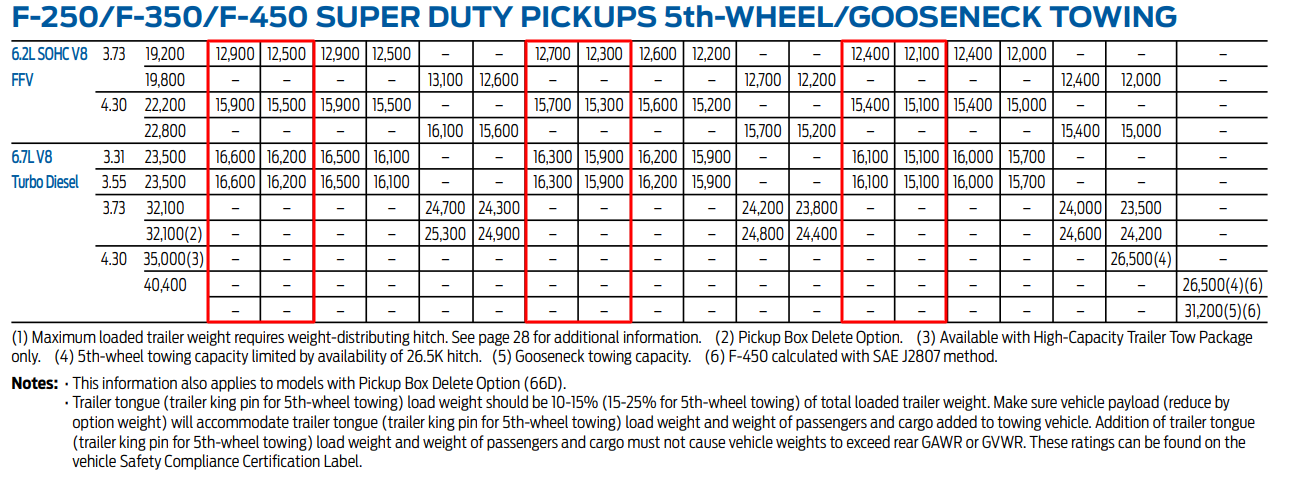
Trailer Frontal Area Considerations

Tongue Weight Rating:
The tongue weight ratings were also listed in the charts, but we're located at the bottom and smaller print, which I posted a larger view of below. If we read the tax, we can see that Ford recommends a 10 to 15% tongue load weight rating for conventional hitches and a much higher 15 to 25% tongue weight if you're using a fifth wheel or gooseneck hitch.
It is important to note that the tongue weight rating does take away from your payload capacity, as it directly affects the gross vehicle weight rating, due to the additional weight that it puts on the rear of the truck.

What Axle Ratio Do I Have?
You will need to know your axle ratio, in order to find the accurate maximum trailer weight rating that was specified in the charts. If you open your driver side door, you will see a safety certification label that looks like the image below and in the bottom center of that label, you will see the word "axle" with a two-digit code beneath it. That code lists the axle ratio that was installed at the factory.
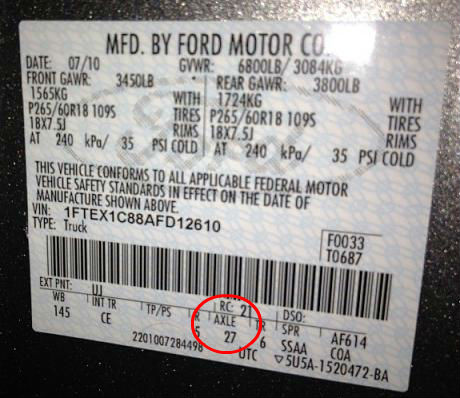
After you have that two-digit figure, you will have to use the chart below to plug in those figures to see what axle ratio you had on your vehicle. The two-digit code will correspond to the rear axle ratio on the left-hand side of the column and I posted the entire axle ratio chart, but remember the 2016 F250s only had the axle ratio options of: 3.31, 3.55, 3.73 and 4.30.
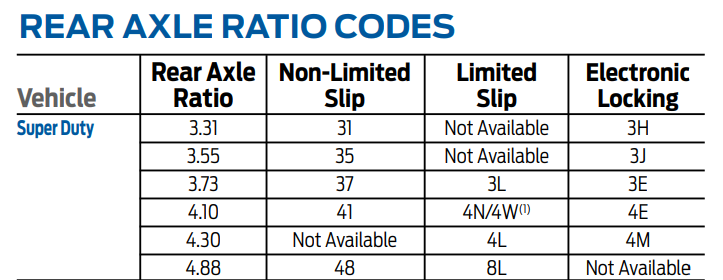
SRW vs DRW:
If we refer back to the charts again, we can see that there are two abbreviations listed in these are listed as SRW and DRW. Now these just simply mean what was equipped on the rear wheels and SRW stands for single rear wheel, while DRW stands for dual rear wheel or dual he's in the back.
If I look at the data, it seems that the 2016 models only had the single rear wheel axle and the Dual rear wheel axles were reserved for the F350s and heavier duty trucks, which also shared the chart with the F250s.
Trim Levels Explained:
There we're five different trim levels available for these trucks and these were listed as the: XL, XLT, Lariat, King Ranch and Platinum trim levels. The trim level you had equipped on your truck did not seem to affect the trailer weight ratings, it only had an impact on the ratings due to the available options for the specific trim levels.
For instance, you might only have one engine option and cab configuration style for the Platinum level trim, which would limit your overall trailer weight rating, to some degree.
Cab Styles...
There were also three different cab styles listed at the top of the charts, that you will have to plug into the chart in order to get an accurate figure. I was able to find an image online that lays out the three different cab configurations that were available for these trucks and as you can see they were listed as: a regular cab, a super cab and a supercrew cab or crew cab.
The cab configuration you had equipped on your truck did make quite a bit of difference in the overall weight ratings, having a difference of a couple of hundred pounds on the lower end, but having a difference of 2,000 lbs. or more, in some cases, so it is important that you plug in the appropriate cab configuration to get an accurate number.
GVWR and GAWR Figures:
GVWR & GAWRs: The gross vehicle weight rating and gross axle weight ratings were not listed anywhere in the owner's manual or the guide that I used for the research of this article, but I was able to find information on where you can look these ratings up.
GCWR: The gross combined weight ratings were listed in the charts on the left-hand column, just to the right of the axle ratios, which makes finding these figures really easy.
Certification Label: If you open the driver side door on your vehicle, you will find a label that looks a lot like the one that's shown in the image below and this will have all sorts of helpful information about your truck. If you look on the top of this label, you will see the gross vehicle weight rating listed, along with the gross axle weight ratings for the front and rear axles, as shown in the image below.
It also shows the axle code at the bottom of the label, like we discussed earlier.
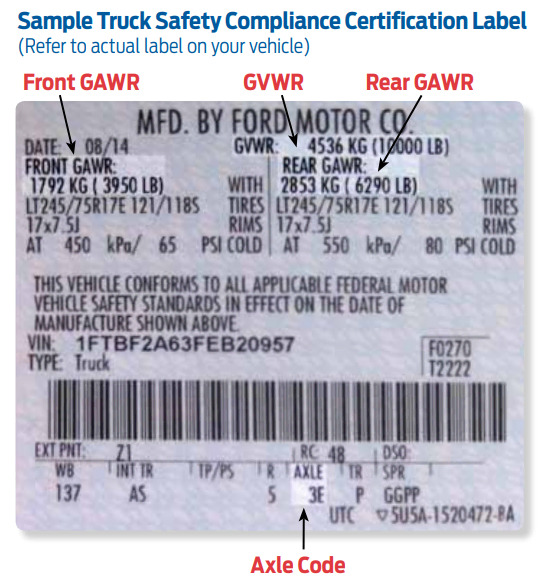
Standard Equipment & What's Included...
I was also able to find the standard equipment that came with these trucks and they were listed in a chart, that I have posted below. These trucks came with all of the standard equipment that you would usually find when pulling a trailer like the wiring harnesses,a receiver hitch, Etc.
This was a nice feature for these trucks because you don't need to buy additional accessories, like you would with the F-150's.
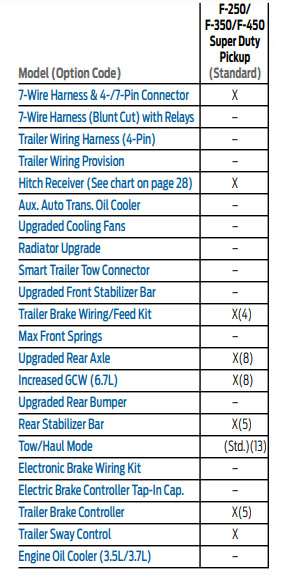
(4) In-cab, no controller (SRW). (5) F-350 DRW; F-450. (8) F-350 4x4 DRW/F-450 only. (13) Diesel engine only
Trailer Brakes:
You will also need to have trailer brakes installed on your trailer if it weighs 1,500 lbs. or more, which I was able to find listed in the owner's manual and posted a screenshot of what I found in the image below.
You will want to check with your local vehicle codes to see if that 1,500 pound rating that was required by Ford satisfies your local law enforcement's code.
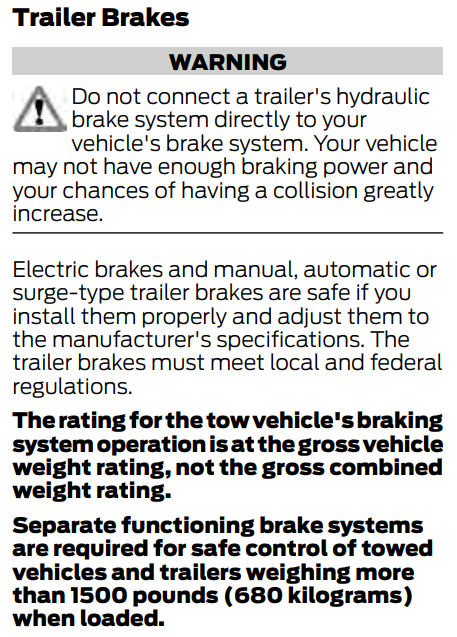
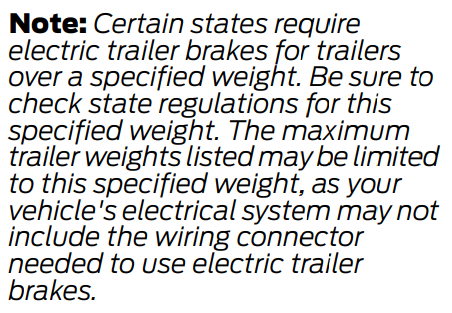
Other Notes I Found:
I was also able to find another additional note in the owner's manual that talks about the gross combined weight rating and how if you are planning on traveling to a higher elevation area, then you will have to reduce the gross combined weight rating by 2% for every 1,000 feet of elevation.
That means that if you were traveling somewhere where it is 2000 feet in elevation, you will have to reduce the gross combined weight rating that was listed in the charts by 4%.
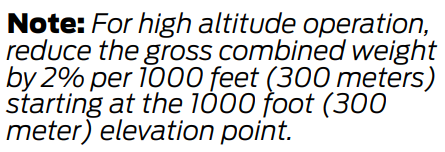
Sway Control Requirement
Helpful Links:
I used two main resources for the research of this article and I have listed these two resources below, for those of you out there that want to check those out yourself. Most of the information in this article came from the guide, including most of the images, but the owner's manual also came in helpful and is where I found all of the other additional information.
Last updated on April 27th, 2022 at 06:47 pm

